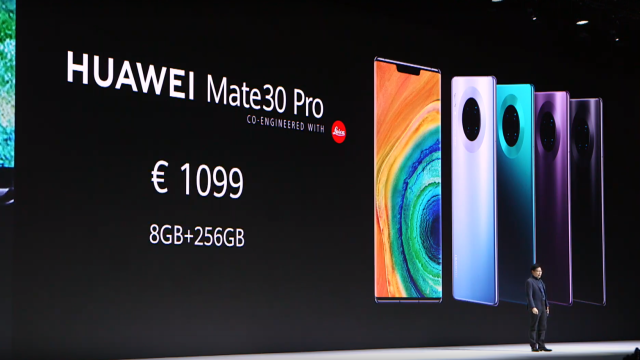Now that Apple has announced its latest batch of iPhones, it’s time for Huawei to hit back with some high-end phones of its own, the Mate 30 and Mate 30 Pro.
Like pretty much every other premium phone released this year, the Mate 30 comes with a triple rear camera module, while the Mate 30 Pro gets one more cam for a total of four. To differentiate itself from Apple and other competitors, Huawei calls the Mate 30’s rear camera bump a “Halo Ring.”
Huawei claims that in order to give the Mate 30 improved ergonomics, it’s eliminated any sharp exterior edges on the Mate 30 while also deploying its new Horizon display. The Horizon display essentially takes what Samsung and others have been doing with 3D glass and curved screens on phones like the Galaxy S10 and pushes things even further, so that the Mate 30’s display wraps 88 degrees around the sides of the phone, creating a true edge-to-edge screen with no side bezels.
From afar, the effect is definitely eye-catching, but for people who prefer the flatter screens on phones like the Pixel 3, Huawei’s new Horizon display may be even more divisive.
As for the Mate 30’s screen itself, Huawei is using a notched 6.62-inch 2340 x 1080 OLED display, with a 19.5:9 aspect ratio, support for DCI-P3 HDR, and a “Cinematic Colour Rendering Engine” that adjust can things like colour saturation to match your content. Meanwhile, the Mate 30 Pro gets a slightly smaller but higher-res 6.53-inch screen with 2400 x 1176 pixels.
Also, despite both phones being more than 10 per cent lighter than the iPhone 11 Pro Max, Huawei has crammed in significantly larger batteries, with the Mate 30 getting a 4,200 mAh power pack, and the Mate 30 Pro doing even better with a 4,500 mAh battery.
Inside the Mate 30’s notch, Huawei has included an array of cameras and sensors including two 3D depth camera for precise facial recognition, ambient light and proximity sensors, a front-facing camera, and a new gesture sensor, which looks to deliver capabilities similar to the Motion Gestures Google has teased for the Pixel 4.Â
In order to preserve as much screen real-estate as possible, Huawei also axed the Mate 30’s earpiece speaker, and instead opted for acoustic display tech that vibrates the phone’s main display, turning the entire screen into one large speaker.
This sense of minimalism can also be seen in the Mate 30’s volume controls, as Huawei has removed the phone’s physical side button in favour of a touch-sensitive virtual key. Now, you just tap the side of the phone in the right spot to raise or lower volume. And like all good flagship phones, the Mate 30 comes with built-in water-resistance, though the Mate 30 Pro’s IP67 rating is a bit better than the standard Mate 30’s IP53 rating.
Inside, the Mate 30 is powered by the Kirin 990, which not only supports both standalone and non-standalone 5G networks, it’s the first 16-Core Mali G76 GPU and includes what Huawei claims is DSLR-level noise reduction capabilities. Huawei also says the Mate 30 has one of the most advanced antenna setups on the market with 21 total antennas, 14 of which are reserved for 5G reception.
In back, the Mate 30 features a 40-MP “SuperSensing” camera, a 16-MP ultra-wide camera, and an 8-MP 3x telephoto cam. That said, if camera quality is your most important feature on a phone, you’ll probably want to go with the Mate 30 Pro, which features a fourth 40-MP “Cine Camera” for video, which features a relatively large 1/1.54-inch sensor and support for real-time bokeh adjustment and 7680 fps ultra-slow motion. So when you combine that with the 1/1.7-inch sensor on the SuperSensing camera, which has a max ISO of 409,600, the Mate 30 Pro seems like a worthy rival for the rest of this fall’s new handsets.
And while Huawei isn’t using the same colour-changing paint jobs used on the P30, the Mate 30 will still come in a wide range of hues including black, space silver, cosmic purple, emerald green, the latter of which features a new finish that transitions from glossy on top to matte at the bottom. And in case that’s not enough, Huawei also has two other styles with vegan leather backs available in orange and forest green.
Finally, like Huawei’s previous phones, the Mate 30 features an in-screen fingerprint reader and wireless charging (and reverse charging), which has now been boosted with 27-watt charging speeds, which is three times faster than what you got on the P30.
While Huawei did not provide an exact release date for its new phones, we do know how much they will cost, with Huawei Mate 30 going for €800 ($1,300) for an 8GB of RAM/128GB of storage config, while the Mate 30 Pro will go for €1,100 ($1,788) for 8GB of RAM and 256GB of storage, with the Mate 30 Pro 5G going for €1,200 ($1,950). There will also be a limited edition Porsche Design Mate 30 RS priced at €2,100 ($3,413) for 12GB of RAM and 512GB of storage.
Editor’s Note: Exact Australian pricing is yet to be confirmed.
With Huawei facing a ban on using American-made tech slated to go into effect in November, it’s unclear if the Mate 30 will ever see a release in larger Western markets like the U.S. Additionally, because that ban may prohibit Huawei from pre-installing the Google Play Store, Huawei also highlighted at its press conference in Munich its App Gallery store, which looks to be the main avenue of finding and downloading apps on Huawei phones going forward.
